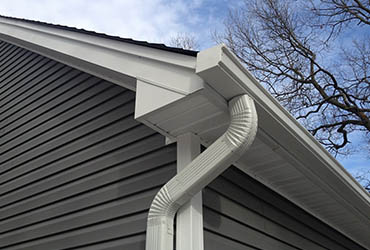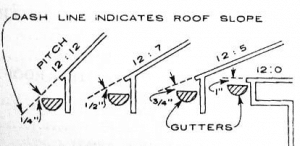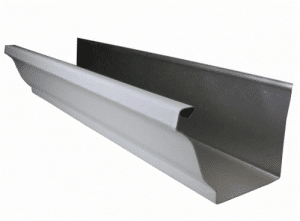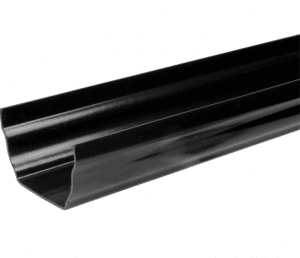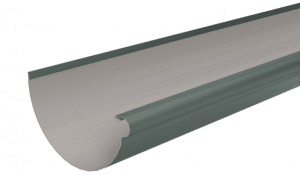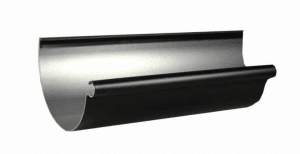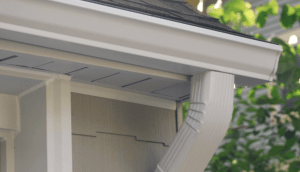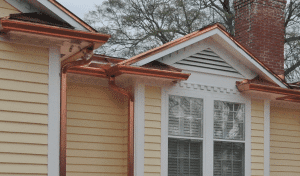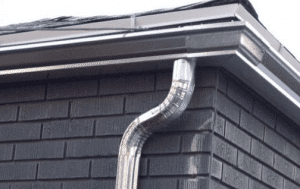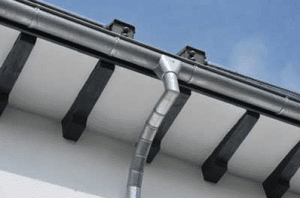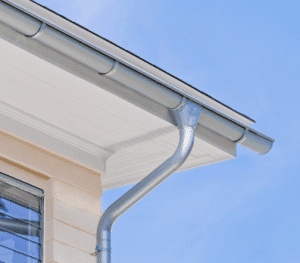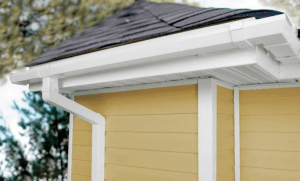Many homeowners don’t give a second thought about gutter slope, but the proper gutter slope is essential to the overall function of your gutter system. Some signs that you need to repair or replace your gutters are more obvious than others. However, other, more unnoticeable issues can indicate poor gutter functionality, such as gutter slope. Also known as gutter pitch, this is the amount by which the gutters slant downward along the path of water flow. The gutter slope should be mostly indistinguishable as your gutters should appear parallel to the roofline from a distance. Without a proper gutter slope, water will begin to pool in your gutters during rainstorms and will not continue to flow into your downspouts. It is important to have the proper gutter slope. Too much of a slope will look strange, reduce the water capacity of the gutters, and potentially cause water to splash over the top of the gutters during an active rainstorm.
How Much Should Gutters Slope?
The proper slope for your gutters will vary depending on the gutters’ length and what kind of gutters you have installed. Gutters should have at least a quarter-inch of slope for every 10 feet of gutters slope in the direction of the downspout.
Example: If you have 40 feet of gutters, the calculation to determine the proper gutter slope would be ¼ x 4 = 1 (i.e., 1 inch). This means that the downspouts on the end of each gutter should be set 1 inch lower than the other end.
How to Measure Gutter Slope
To calculate gutter slope, you will want to attach one end of a long string to the highest point of your gutters and the other end at the location of your downspout. Utilize a string leveler to ensure that the string is completely parallel to the ground. Measure the length of the string to determine the distance between the two points. As mentioned in the example above, if you have 40 feet of gutters, you already know the slope should be 1 inch. Take the downspout end of the string and lower it by 1 inch and reattach it. Mark both ends of the string with a pencil or chalk and then remove the string. Snap a chalk line between the two marked points to determine the line your gutters will follow. Repeat this process for every run of gutters around your roofline.
Problems Due To Improper Gutter Slope
Too Much Pitch
When the gutter pitch is miscalculated and has too much pitch, the sharper angle can cause rainwater to move too quickly. Overflowing gutters send undirected water up into your soffit and fascia board, risking wood rot in these areas. The undirected water can also flow down your siding, causing potential damage and getting into cracks in your foundation, which can lead to your foundation becoming compromised and an extremely costly repair.
Too Little Pitch
If the water flow in your gutters is slow or non-existent, it is likely a sign of a gutter system with an improper gutter pitch. If you do not have enough pitch in your gutters, water will be unable to move downward. Water will then begin to collect into your gutter system, which in turn weighs down your gutters, puts stress on the fascia board, and eventually will damage both the gutters and fascia board. The added weight of the water will pull the gutters away from your home and give them a “sagging” appearance.
Debris Collection
The improper gutter pitch will not allow your gutters to effectively flush out leaves or other debris that can accumulate in gutters. As debris accumulates in the gutter system, it will combine with standing water and, over time, turn into sludge, which adds more weight to the gutters and puts your gutter system at risk of loosening from its brackets falling away from home.
Gaps in Gutter System
When gutters have an improper pitch, it can create gaps where water will escape between the back of the gutter section where your fascia board is located. This could cause the water to run down one specific area on the exterior of your home, damaging siding or eroding brickwork, and will also cause water damage to the fascia board. More often than not, these gaps go undetected for long periods and can lead to costly repairs.
Roof Gutter Types
K-Style Gutters
K-style gutters are one of the most popular gutter types used, and if you buy a home, it will likely have this type of gutter installed on it. K-style gutters are popular due to their appearance and how decorative they are. K-style gutters have a curvier profile than other gutter types available on the market, and they closely mimic the appearance of crown molding. These types of gutters can hold more water than other gutter types, which is why they are a popular choice for homeowners. K-type gutters come in a wide range of sizes and materials, and since they are flat on the back, K-style gutters can be screwed flush against your home, creating a seamless appearance.
Victorian Ogee Gutters
Also referred to as “Old Gothic” gutters, this type of gutter is very distinctive and has a decorative appearance that looks amazing on specific homes. This style of gutter is based on cast-iron gutters that were extremely popular during the 19th century. However, they are more modernized and give off the aesthetic of a traditional yet stylish gutter. This type of gutter is shallow, which means that it cannot handle a large amount of water flow compared to other gutter types. You will usually find this type of gutter installed on more traditional homes that are Victorian-style and smaller homes due to the shallowness of the gutter. A significant benefit of these gutters is that they can be custom-made to your exact preference.
Half-Round Gutters
Half-round gutters are another popular choice of gutters as they will add to the aesthetic of your home without being overly flashy. This type of gutter is typically more traditional in appearance and works well on homes with a certain architectural style. This type of gutter also comes in several different styles, such as single-bead, double-bead, or reverse bead style. Regardless of the type of half-round gutters you choose, it will not affect how the gutter performs or the difficulty of installing them on your home. These gutters also come in a range of different materials, making it easy for homeowner to customize their gutters. These gutters can be easily cut to match the length of your home and have options for hidden hangers so that you cannot see how the gutters are attached to the house.
European Gutters
European gutters are half-round gutters that have the bead on the outside of the gutter. These gutters are also installed on your home using a visible half-round hanger. Many homeowners choose to install this type of gutter because they offer a pleasing aesthetic and adds a lot of curb appeal to a home. It is especially true when this style of gutter is installed using copper. This type of gutter is an excellent choice if you live in an area prone to temperature fluctuations or severe storms. They are generally made from more robust materials and can hold up in severe storms that damage other gutter types or rip them entirely away from your home.
Gutter Materials
Aluminum Gutters
Aluminum gutters are the most common type of material used for gutters that are currently available. Aluminum gutters are incredibly lightweight and easy to install. Additionally, you will not have to worry about any corrosion affecting your gutter system. You can easily match the color of your gutters to the rest of your external color scheme as there is a wide variety of colors available in aluminum gutters. This type of gutter material is also more cost-effective than other materials.
Copper Gutters
This type of gutter material is much more expensive than its aluminum counterpart. Still, when homeowners choose copper as the material for their gutters, they are not looking to save money. With proper installation, you should not have to worry about mold or mildew growth, nor will you worry about painting them. The copper will begin to patina over time and add to the curb appeal of your home. Unfortunately, copper gutters have the same general lifespan as aluminum gutters and are easily damaged by a falling tree or large limb as copper is a soft metal.
Galvanized Steel Gutters
Galvanized steel gutters are simply steel that has been coated with a thin layer of zinc to protect the steel. These gutters are solid, but they do rust if they become damaged. Homeowners who choose to install this type of gutter must be ready to have necessary repair work and must have repairs completed quickly should the gutters get dented or scratched to avoid rusting. This type of gutter also requires a professional to install as if they are installed incorrectly. There may not be enough drainage in the gutter. If this happens, you will have standing water next to your home. If you choose to have this type of gutter installed on your home, it is also very important that you clean them out regularly to remove any debris that could cause a clog and keep away any rust.
Galvalume Gutters
Galvalume gutters are another type of steel gutter coated with a combination of zinc and aluminum, making this material a solid gutter choice that can stand up against damage and rust. Galvalume gutters are made by dipping steel into liquid zinc and aluminum and are considered a specialty gutter that you have to work with a professional to get. A significant factor to consider when you are thinking of installing galvalume gutters is the climate you live in. These types of gutter can outlast galvanized steel, but when installed in certain climates, they can last up to nine times longer than galvanized steel gutters.
Zinc Gutters
Zinc gutters are a much more significant investment when compared to aluminum gutters, but they will usually last twice as long. These gutters are made from zinc with small amounts of copper and titanium and are typically left unpainted. Over time, zinc gutters will develop a protective coating, or patina, similar to copper gutters that will help to protect them from the outside elements.
Vinyl Gutters
When compared to other gutter materials, vinyl gutters are much less expensive. Vinyl gutters are made using strong plastic that will protect the gutters from being dented or bent. Vinyl gutters will also never corrode, making them a great choice if you live in an area with regular heavy storms but do not feel like cleaning your gutters out after every storm. These types of gutters are also incredibly lightweight, which makes them easy to cut and install. When purchasing vinyl gutters, you want to make sure that you buy the correct thickness. Thinner vinyl gutters will sag with age and can grow brittle and shatter. You want to consider this, especially if you live in a colder climate because cold temperatures are detrimental to vinyl.
Do you need a Gutter Slope Adjustment in Charlotte, NC?
Signature Exteriors has been proudly servicing Charlotte and surrounding areas for 10 years now. We pride ourselves on our work quality and would love to work with you! If you think your gutters may be sloped improperly, would like a general inspection of your gutter and roofing systems, or would like to discuss what style and material of gutter are best for your home, give us a call today at (704) 729-4898!

